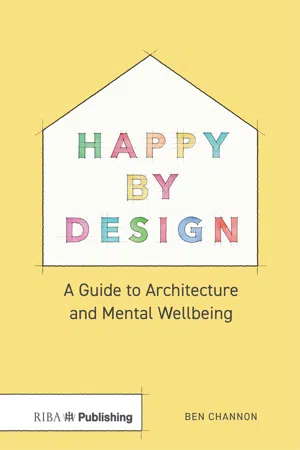
eBook - ePub
No longer available |Learn more
Happy by Design
A Guide to Architecture and Mental Wellbeing
Ben Channon
This book isn’t in the library right now, search for another
- 224 pages
- English
- ePUB (mobile friendly)
- Available on iOS & Android
eBook - ePub
No longer available |Learn more
Happy by Design
A Guide to Architecture and Mental Wellbeing
Ben Channon
Book details
Table of contents
Citations
About This Book
Can good design truly make us happier? Given that we spend over 80% of our time in buildings, shouldn't we have a better understanding of how they make us feel? This book explores the ways in which buildings, spaces and cities affect our moods. It reveals how architecture and design can make us happy and support mental health and explains how poor design can have the opposite effect.
Presented through a series of easy-to-understand design tips and accompanied by beautiful diagrams and illustrations, Happy by Design is a fantastic resource for architects, designers and students, or for anybody who would like to better understand the relationship between buildings and happiness.
Frequently asked questions
How do I cancel my subscription?
Can/how do I download books?
At the moment all of our mobile-responsive ePub books are available to download via the app. Most of our PDFs are also available to download and we're working on making the final remaining ones downloadable now. Learn more here.
What is the difference between the pricing plans?
Both plans give you full access to the library and all of Perlego’s features. The only differences are the price and subscription period: With the annual plan you’ll save around 30% compared to 12 months on the monthly plan.
What is Perlego?
We are an online textbook subscription service, where you can get access to an entire online library for less than the price of a single book per month. With over 1 million books across 1000+ topics, we’ve got you covered! Learn more here.
Do you support text-to-speech?
Look out for the read-aloud symbol on your next book to see if you can listen to it. The read-aloud tool reads text aloud for you, highlighting the text as it is being read. You can pause it, speed it up and slow it down. Learn more here.
Is Happy by Design an online PDF/ePUB?
Yes, you can access Happy by Design by Ben Channon in PDF and/or ePUB format, as well as other popular books in Architecture & Architecture General. We have over one million books available in our catalogue for you to explore.
Information
Table of contents
- Cover
- Title
- Copyright
- Contents
- Acknowledgements
- About the Author
- Introduction
- 1: Light
- 2: Comfort
- 3: Control
- 4: Nature
- 5: Aesthetics
- 6: Activity
- 7: Psychology
- Conclusions
- Notes + References
- Index